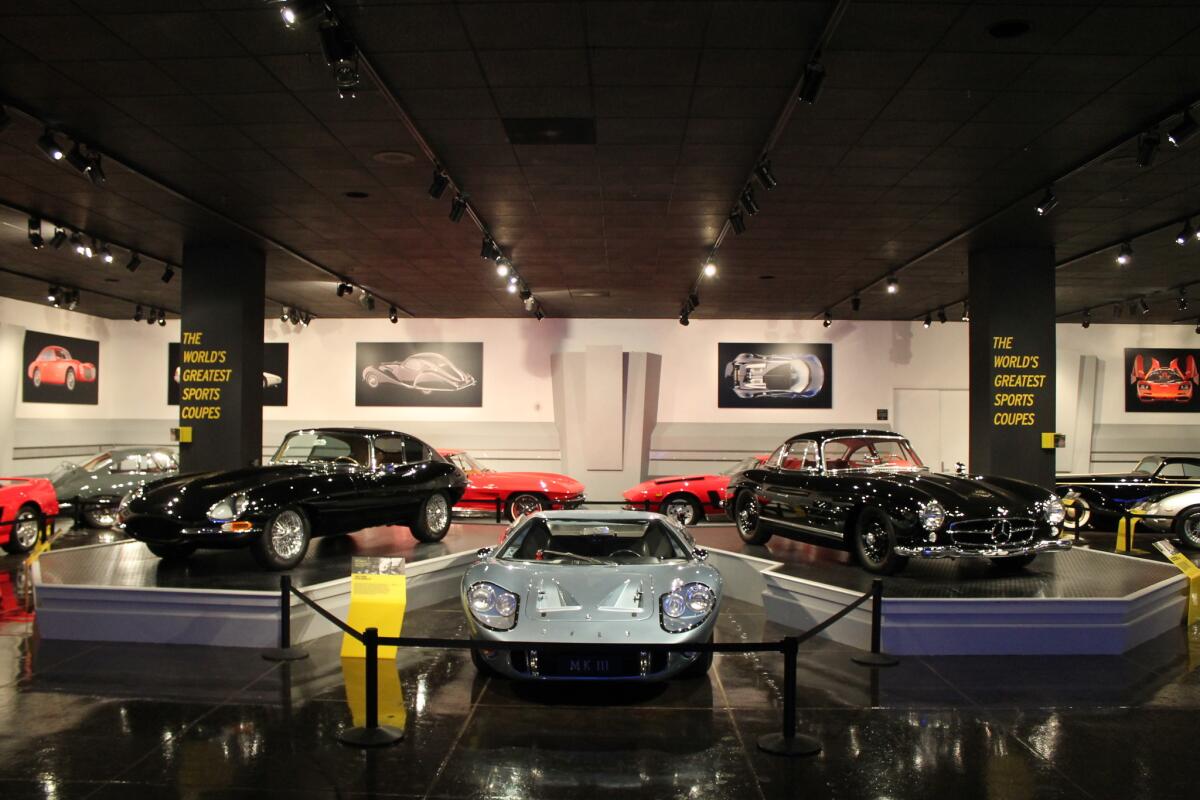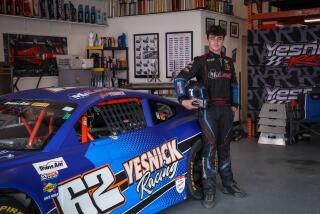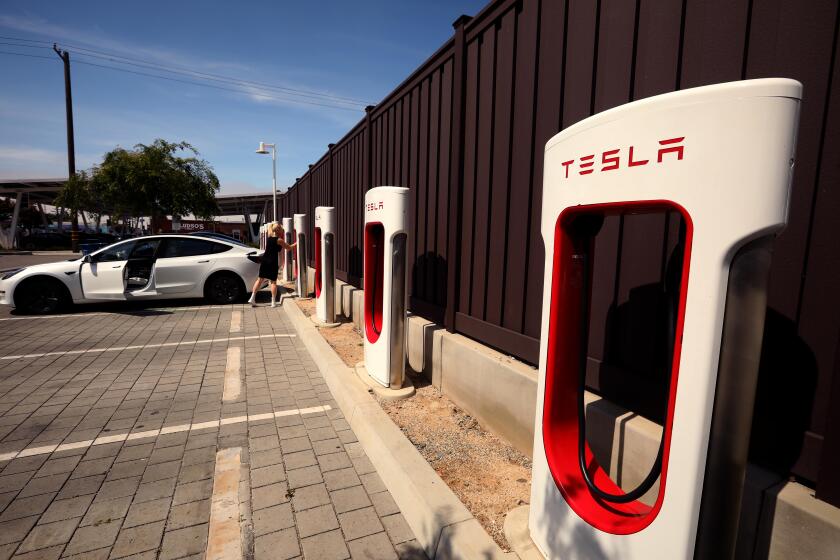Ian Callum’s thoughts on Petersen’s greatest sports coupes

Beauty and cars aren’t new to Los Angeles. But for the next six months you’ll be able to see highlights of both at the Petersen Automotive Museum.
The organization has on display a new exhibit called the World’s Greatest Sports Coupes. The collection is sponsored by Jaguar as a way to promote its all-new F-Type Coupe. Twelve auto-friendly celebrities were asked to submit what they thought was the most beautiful sports coupe ever made.
“Sports coupes are the reason most of us fell in love with the automobile in the first place,” said Terry Karges, the Peterson’s executive director. “These vehicles represent the pinnacle of art, design, engineering and performance and have been built all over the world.
PHOTOS: World’s greatest sports coupes at the Petersen
The exhibit, which runs until Oct. 18, includes marques like Ferrari, Corvette, Aston Martin and Mercedes. Curious to hear his personal thoughts on the styling of each car, we grabbed Ian Callum, Jaguar’s design director. Callum is no stranger to creating beauty: He’s the pen behind the current Jaguar lineup and most of the modern-day Aston Martins many of us drool over.
Callum shared with us his thoughts on which of these cars first inspired him to become a car designer when he was 5, why the Acura NSX looks clumsy, what many Corvettes have been lacking and the future of mid-engined sports cars -- especially with a Jaguar logo on them.
Here’s Callum’s take on each of the 12 cars.
1961 Aston Martin DB4 Zagato chosen by Ian Callum, Jaguar’s director of design
“I chose this because I have a little bit of background with Astons, so it sort of speaks to me.
“I just love the dynamic of the lines of this car. If you look at the first new Vanquish [which Callum designed], it has strong shoulder line. This was the influence. It has a beautiful line down the side. We reinterpreted it to make it look more modern. But even the door sections and everything are something that were inspired by this car.
“The thing that’s interesting about this car is no two are alike. They’re all different. It’s kind of hit or miss finding one you really like. I know this one, and I’ve driven this one, and I’ve always liked it. I’m sure it’s probably got a sister out there somewhere. I just love the combination of Italian design and British engineering. It’s lovely.
“I always say an Aston grille has kind of a smirk to it. Kind of a James Bond knowing smirk.”
1962 Ferrari 250 GTO chosen by Pink Floyd’s Nick Mason
Says Callum: “You know, this is not my favorite Ferrari because I’ve never really liked how these haunches in the front disappeared into the front fender and kind of flipped up over the windscreen. The emphasis is right at the front of the car.
“And of course you have these famous slits in the front, which I’m sure were probably thought of at the last minute to get more air in there because the grille was tiny. And this is a generic-shaped grille for the time, because Jaguar did it as well.
“I mean it’s a dramatic car, it’s quite a handsome car. But my favorite is still the 250 SWB from the same year.”
1948 Jaguar Custom “Black Pearl” chosen by Metallica’s James Hetfield
Says Callum: “I actually saw this for the first time on Twitter about two days ago. This is the first view I’ve had of it. And I was really taken by it.
“I love the car, I think it’s a beautiful car. It’s based on a Jaguar Mark IV and has an XK engine inside it. I love the car, but I think they should have kept the Jaguar grille at the front. That’s my only comment really. I’m not sure about the gold. I think that’s a bit rock ‘n’ roll for me. I think a nice satin silver color would have been nicer. But that’s personal taste.”
1974 Iso Grifo chosen by AC/DC’s Brian Johnson
Says Callum: “I’ve always loved these cars, it’s very 1970s Italian. I can see this is Brian Johnson’s car because it’s got a Chrysler Hemi in it, and that’s why it has this fascinating sort of hood scoop, which I think looks like Frank Lloyd Wright’s had a go at this at some point. I just love the way it pops up. They didn’t all have these, by the way, there were smaller-engined cars.
“It’s a very simple, powerful car with a very strong American V-8 and Italian body. It’s a pretty car and it’s got rear glass that’s curved and not feasible anymore. You can’t try to make that now with safety glass. But it’s a handsome car, and its notability is this wicked power bulge.”
1963 Chevrolet Corvette Stingray chosen by Top Gear USA hosts Tanner Foust, Adam Ferrara and Rutledge Wood
Says Callum: “It doesn’t get more American than the Corvette. And this is my all-time favorite ‘Vette. I’ve always loved them. I love the horizontal lines coming off the pontoons. Until the very latest ‘Vette, I’ve never really had any great love for the ‘Vette after this car. This for me was the best of the family.
“I love the new ‘Vette. I think it’s a really cool car and it’s worthy of what this car stood for. But all the stuff between them, I don’t get it. Some of those, they’ve just not got that kind of ... ballsiness about them. This is quite a tough-looking car. When you compare it to the [Jaguar] E-Type, one was so American and one was so British and they have their own -- equal -- place in life.”
1964 Porsche 356SC chosen by actor and race car driver Patrick Dempsey
Says Callum: “I have to say, it was a 356, a silver one, that triggered me to be a car designer. I was probably about 4 or 5 years old. This silver car came through town and I asked my grandfather ‘What was that?’ And he said ‘Oh, it’s a Porsche.’ And I thought wow!
“I’ve had three Beetles since then. I love Beetles. But I’ve never had a Porsche. I nearly bought a Porsche 993 once. I wish I had because that’s my favorite. But this is just such an honest, pretty car. It’s just so innocent.
“And they’re so much fun to drive. I love the air-cooled engine in the back and that lovely gear change, just the mechanical feel of it. It’s fantastic. Very beautiful, very elegant car. And despite the fact that the engine hanging off the back is just fundamentally flawed, they persisted,” Callum said, laughing.
“They’re not going to give up. I think the 911 will prevail forever. Of course that gives you the extra room in the back of the cabin, which we can’t do on the Jag [F-Type] because there’s just not enough room. But it is a beautiful little car and I would love to own one. And they’re a great investment. You can’t go wrong with these.”
1991 Acura NSX chosen by Motor Trend magazine’s Angus MacKenzie:
Says Callum: “I’ve always liked this car. But it’s not the most beautiful thing in the world, especially the aero, its pure aerodynamics. This is what aerodynamics does to a car, by the way. It makes it look a little clumsy in the middle. In this case, the greenhouse is slightly out of proportion with the rest of the car. You’ve got a very delicate front end, you’ve got a big cabin, like a big head.
“That to me dates it quickly. But for its time the proportions are very unique. You’ve got this big glass in the front, but it gives you a commanding view of the road.
“I love mid-engined cars, I think they’re the way to go. I always wanted to do a mid-engine Jag. We nearly did a mid-engine Aston once based on the V-8. The F-Type we were doing before [the production model] actually was a mid-engine car, but we stopped that project because we didn’t have enough money to develop it. That’s going back about 10 years now.
“I think why we ended up moving on is because the fundamental architecture we are working with at the moment is a front-engine architecture. We didn’t want to reinvent the wheel.
“I think a mid-engined car will be as prevalent in the future as the front engine, maybe even more so. I think it’s feasible. The problem with a sports car platform is it has to be different from a sedan. You can’t just take a sedan platform and turn it into a sports car. You can take components from it.
“But with a mid-engine, that becomes even more difficult because your drivetrain has to relate to the mid-engine layout. So it’s a difficult thing to do independently. But yeah, I think there’s still a place for it because at the end of the day that’s where you want your weight distribution to be. I could see Jag doing a mid-engined car one day. We’re not doing one now.”
1963 Ferrari Berlinetta Lusso chosen by comedian and TV host Adam Carolla
Says Callum: “This is a beautiful car. It’s got one or two puzzling bits about it. I love the Lusso back that just drops off like that with the big glass. It’s very much a 1960s thing, very Italian, with the bubble glass top sitting within the haunches, the very subtle haunches.
“Lussos for me always dropped off a little too much at the back. They’re falling off a bit too much back there. That’s why I love the GT ... it goes a bit higher. But this is a gorgeous car in a gorgeous color and the state of that metal is just perfect, isn’t it? It’s so elegant. There were lots of different Lussos from this time. For that year, there were lots of Ferraris on sale and you almost had to line them all up to see which one you liked better than the other. They’re all slightly different.”
1967 Jaguar E-Type chosen by American racer and team owner Bobby Rahal
Says Callum: “I love the E-Type. It’s just a piece of perfect work. The reason it’s so pure is Malcolm Sayer [the car’s designer] was an aerodynamicist. He had a styling notion, he was very influenced by the Alfa Romeo Disco Volante.
“The E-Type is such a known quantity now but it’s actually a very geometric car. People see it almost as a sort of voluptuous, curvaceous car, but if you actually analyze all the geometric sections, they are pure geometric sections. There’s not a loose line on there.
“That’s why it came out so beautifully because the car was created geometrically. The man had a formula for taking shapes, which he learned from a German aerodynamics engineer, about how to create forms for aerodynamics.
“That’s why we love it, because it’s actually born out of utter discipline. There’s nothing frivolous in its styling. Nothing. An interesting thing about this car: The first E-Types were supposed to be convertibles. At the last minute, the guys in the metal shops cobbled together a coupe and that’s the one that went to Geneva as the new E-Type.”
1968 Ford GT40 Mark III chosen by John Lasseter, chief creative officer of Pixar and Disney
Says Callum: “What I love about this car is it was designed in a shed in Essex by a couple of clay modelers, who put it together under the instruction of the engineers and designers, and they modeled it up. And this was going to be the new race car that Ford was going to build to take on Ferrari because they wanted to buy Ferrari and Ferrari said no. So Ford said ... we’re going to beat you at LeMans.
“And it started off as a race program in England and things didn’t work out very well. And the program then came to the U.S. and was finished off in the U.S.
“I think the Mark I and Mark IIs were a bit prettier. This one had been designed with a back end for the U.S. and it’s lost a bit of that shapeliness at the back. It was for aero, it’s all aero. These cars were driven by physics, they weren’t driven by aesthetics.
“Of course the Mark II, they sold in England, they had a whole batch of them left and turned them into production cars. And I remember opening the Sunday Times magazine when I was about 12 or so and they were trying to sell these GT40s for about 4,500 pounds. But they were stuck with these cars, so many of them, didn’t know what to do with them. And decades later they become iconic. It’s incredible.
“And wow is that a low car. Forty inches high. Imagine jumping into that, running across the road at LeMans and getting into this thing. You had to be taking your head off in the process.”
1955 Mercedes-Benz 300 SL Gullwing chosen by world renowned car collector Bruce Meyer
Says Callum: “This is not a beautiful car. It’s a very handsome car. Beauty has more of an emotional feel about it. You see something which has got an elegance to it. Whereas this is a little bit more brutal. It’s very matter of fact. It’s beautifully done, but it hasn’t got that natural svelteness to it that the Ferrari or the Aston has. And I love it for it. It’s exaggerated, it’s all kind of sections and it’s very muscular. I wish Mercedes still had that sense of strength.”
1954 Plymouth Explorer Concept chosen by film director and producer Francis Ford Coppola
Says Callum: “Exner did a whole series of these cars for Chrysler. This is a one off. It’s a very dramatic car. Think of what a 1954 Chevy looked like. This really forward grille has this thrusting futuristic look to it for the time. And all that wrapped glass at the back was impressive. It’s a beautiful color. I really like it.”







